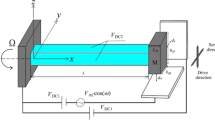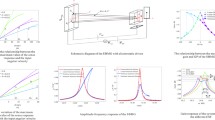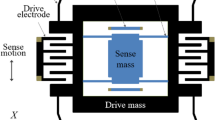Abstract
This paper is based on a T-beam resonator with the addition of a piezoelectric structure. T-beam resonator is redesigned as the T-beam micro-gyroscope with a hybrid electrostatic-piezoelectric driving. The sensing and driving modes of the gyroscope are designed to have a 1:2 frequency ratio with the lower-order sensing modes excited by two-to-one internal resonance. Specifically, the dynamics of the gyroscope with hybrid-driving is modeled by using Lagrange’s equations. The two flexural modes of in-plane modes of T-beam are obtained by using Hamilton's principle and the beam is dimensioned to obtain an accurately tuned two-to-one internal resonance structure. Lagrange’s equation is used to develop a dynamical model and the Galerkin method is used to get a reduced-order model with two degrees of freedom. The model preserves the quadratic nonlinearities of the coupled modes while retaining the high-order terms of the electrostatic force to study the static pull-in voltage. The response of the gyroscope for three sensing mode bandwidths in vacuum and non-vacuum environments with two quality-factors is analyzed. The results show that the internal resonance can significantly improve the response bandwidth of the gyroscope, while the input energy of gyroscope increases significantly under the effect of hybrid-driving, which makes the performance of the gyroscope improve in both operating environments. In particular, the advantage of the hybrid-driving is more obvious in the lower quality-factor operating environment. It proves the great potential of T-beam gyroscope with hybrid-driving.





















Similar content being viewed by others
Data availability
The datasets generated during and/or analysed during the current study are not publicly available due to Subsequent papers were not published but are available from the corresponding author on reasonable request.
Abbreviations
- I :
-
Number of beams
- j :
-
Number of modes
- (X i, Y i):
-
Coordinate system of the beam
- L i :
-
Beam length
- h i , h p :
-
Thickness of beams and piezoelectric sheets
- w i , w p :
-
Width of beam and piezoelectric sheet
- ρ , ρ b :
-
Density of beams and piezoelectric sheets
- m i :
-
Mass of beams
- M :
-
Mass per unit length of the beam
- Ω :
-
Input angular velocity
- l i :
-
Length of electrode
- d i :
-
Spacing of electrode plates
- l p 1 , l p 2 :
-
Distance of start and end of piezoelectric layer to clamped end of the beam
- e io :
-
Strain along the axis
- v i(x,t), u i(x,t):
-
Lateral and axial deflection of beams
- T :
-
Kinetic energy
- U :
-
Potential energy
- r p(x,t):
-
Position vector of beam L3
- V DC1 , V DC2 :
-
Electrostatic DC voltage
- V 1(t):
-
Electrostatic AC voltage
- V p(t):
-
Piezoelectric AC Voltage
- \(\phi\) :
-
Electric potential
- E 3 :
-
Electric field component
- s i :
-
Length of undeformed beam
- I i , I p :
-
Rotational inertia of beam and piezoelectric sheet
- E , E p :
-
Young's modulus of beam and piezoelectric sheet
- T T :
-
Piezoelectric beam stress
- T S :
-
Axial normal strain for the beam
- d 31 :
-
Piezoelectric constant of the piezoelectric actuator
- ε 33 :
-
Dielectric coefficient
- D 3 :
-
Potential shift
- s 11 :
-
Elasticity coefficient
- H(x):
-
Heaviside function
- ε 0 :
-
Absolute permittivity
- ε r :
-
Dielectric constant of the gaps
- ϑ i :
-
Scaling parameters of the beam
- τ :
-
Dimensionless time
- α :
-
Dimensionless bending stiffness
- F 0 i :
-
Coefficient of DC electrostatic force term for each electrode
- F 1 i :
-
Coefficient of AC electrostatic force term for each electrode
- F p :
-
Piezoelectric AC voltage term factor
- φ ij(x):
-
Mode shape type at natural frequency
- ω j , ω Δ j :
-
Natural frequency and the amount of natural frequency change
- σ 1 , σ 2 :
-
Detuning parameters
- A j(x,t):
-
Modal amplitudes
- A j 0(x):
-
Static displacement
- a j(t):
-
Time-dependent oscillatory components
- Q 1 ,Q 2 :
-
Quality-factor
- \(\zeta_{{1}}\), \(\zeta_{{2}}\), \(\zeta_{1}^{\prime }\),\(\zeta_{2}^{\prime }\) :
-
Modal damping
- Z 0 /Z :
-
Circuit load
- f xy , h xy :
-
Electrostatic potential terms
- V i :
-
Amplitude (μm)
- SVi :
-
Amplitude (dB)
References
Liu, K., Zhang, W., Chen, W.: The development of micro-gyroscope technology. J Micromech. Microeng 19(11), 113001–113029 (2009)
Shaeffer, D.K.: MEMS inertial sensors: a tutorial overview. Commun. Mag. IEEE 51(4), 100–109 (2013)
Shkel, A.M., Acar, C., Painter, C.: Two types of micromachined vibratory gyroscopes. Sensors, 2005 IEEE. (2005)
Lajimi, S., Heppler, G.R., Abdel-Rahman, E.M.: A parametric study of the nonlinear dynamics and sensitivity of a beam-rigid body microgyroscope. Commun. Nonlinear Sci. Numer. Simul. 50(1), 180–192 (2017)
Ghasemi, S., Afrang, S., Rezazadeh, G.: On the mechanical behavior of a wide tunable capacitive MEMS resonator for low frequency energy harvesting applications. Microsyst. Technol. (2020). https://doi.org/10.1007/s00542-020-04779-9
Venstra, W.J., Capener, M.J., Elliott, S.R.: Nanomechanical gas sensing with nonlinear resonant cantilevers. Nanotechnology 25(42), 425501 (2014)
Ramini, A.H., Hajjaj, A.Z., Younis, M.I.: Tunable resonators for nonlinear modal interactions. Sci. Rep. 6, 34717 (2016)
Ruzziconi, L., Jaber, N., Kosuru, L., et al.: Two-to-one internal resonance in the higher-order modes of a MEMS beam: experimental investigation and theoretical analysis via local stability theory. Int. J. Non-Linear Mech. 129, 103664 (2021)
Atabak, S., Behraad, B., Farid, G.: Analytical modeling and experimental verification of nonlinear mode coupling in a decoupled tuning fork microresonator. J. Microelectromech. Syst. 27(3), 398–406 (2018)
Wang, X., Huan, R., Zhu, W., et al.: Frequency locking in the internal resonance of two electrostatically coupled micro-resonators with frequency ratio 1:3. Mech. Syst. Signal Process. 146, 106981 (2021)
Sarrafan, A., Azimi, S., Golnaraghi, F.: A nonlinear rate microsensor utilising internal resonance. Sci. Rep. 9(1), 1–9 (2019)
Shami, Z.A., Giraud-Audine, C., Thomas, O.: A nonlinear piezoelectric shunt absorber with 2:1 internal resonance: experimental proof of concept. Smart Mater. Struct. 31(3), 035006 (2022)
Ruzziconi, L., Jaber, N., Kosuru, L., et al.: Internal resonance in the higher-order modes of a MEMS beam: experiments and global analysis. Nonlinear Dyn. 103(3), 2197–2226 (2021)
Noori, N.: Analysis of 2:1 internal resonance in MEMS applications. In: Applied Sciences: School of Mechatronic Systems Engineering (2018)
Khbeis, M., Mosteller, M., Ghodssi, R.: Development of a simplified hybrid ambient low frequency, low intensity vibration energy scavenger system. Cap.ee.imperial.ac.uk (2009)
Yang, B., Lee, C., Kee, W.L.: Hybrid energy harvester based on piezoelectric and electromagnetic mechanisms. J. Micro/Nanolithogr. MEMS MOEMS 9(2), 023002 (2010)
Eun, Y., Kwon, D.S., Kim, M.O., et al.: A flexible hybrid strain energy harvester using piezoelectric and electrostatic conversion. Smart Mater. Struct. 23(4), 045040 (2014)
Koh, K.H., Shi, Q., Cao, S., et al.: A self-powered 3D activity inertial sensor using hybrid sensing mechanisms. Nano Energy 56, 651–661 (2019)
Zhang, B., Chen, J., Jin, L., et al.: Rotating-disk-based hybridized electromagnetic–triboelectric nanogenerator for sustainably powering wireless traffic volume sensors. ACS Nano 10(6), 6241–6247 (2016)
Vyas, A., Peroulis, D., Bajaj, A.K.: A microresonator design based on nonlinear 1: 2 internal resonance in flexural structural modes. J. Microelectromech. Syst. 18(3), 744–762 (2009)
Vyas, A., Peroulis, D., Bajaj, A.K.: Dynamics of a nonlinear microresonator based on resonantly interacting flexural-torsional modes. Nonlinear Dyn. 54(1), 31–52 (2008)
Pan, J., Guan, Z., Sun, W.: Nonlinear oscillations of a dual-joint system involving simultaneous 1:1 and 1:2 internal resonances. J. Sound Vib. 527, 116807 (2022)
Tilmans, H.A.C., De Raedt, W., Beyne, E.: MEMS for wireless communications:‘from RF-MEMS components to RF-MEMS-SiP.’ J. Micromech. Microeng. 13(4), S139 (2003)
Shami, Z.A., Giraud-Audine, C., Thomas, O.: A nonlinear piezoelectric shunt absorber with a 2:1 internal resonance: theory. Mech. Syst. Signal Process. 170, 108768 (2022)
Li, W., Yang, X.D., Zhang, W., et al.: Free vibration analysis of a spinning piezoelectric beam with geometric nonlinearities. Acta. Mech. Sin. 35(4), 879–893 (2019)
Marzouk, A.: Utilization of internal resonance in gyroscope design. Ph.D. dissertation, School Appl. Sci., Mechatron. Syst. Eng.,Simon Fraser Univ., Burnaby, BC, Canada (2014)
Wang, S., Lu, L., Zhang, K., et al.: Design, dynamics, and optimization of a 3-DoF nonlinear micro-gyroscope by considering the influence of the coriolis force. Micromachines 13(3), 393 (2022)
Funding
This work was supported by the National Natural Science Foundation of China (Grant Numbers: 12072234, 11872044 and 12072233) and the Natural Science Foundation of Tianjin City (Grant No. 20JCYBJC00510).
Author information
Authors and Affiliations
Contributions
All authors contributed to the study conception and design. Material preparation, data collection and analysis were performed by KZ, JZ, SH, QZ and JF. The first draft of the manuscript was written by JZ and all authors commented on previous versions of the manuscript. All authors read and approved the final manuscript.
Corresponding author
Ethics declarations
Conflict of interest
The authors have no relevant financial or non-financial interests to disclose.
Additional information
Publisher's Note
Springer Nature remains neutral with regard to jurisdictional claims in published maps and institutional affiliations.
Appendix
Appendix
Coefficient (Г11, Г12, Г22) of kinetic energy term and coefficients (W11, W12, W22) of potential energy term are as follows:
Bi-mode approximation for axial displacement:
Λijk is a spatial function of the dimensionless arc length \(s_{k}\):
Define the coefficient \(Q_{ij}\) as follows:
where,
Coefficients in Eq. (33):
Rights and permissions
Springer Nature or its licensor (e.g. a society or other partner) holds exclusive rights to this article under a publishing agreement with the author(s) or other rightsholder(s); author self-archiving of the accepted manuscript version of this article is solely governed by the terms of such publishing agreement and applicable law.
About this article
Cite this article
Zhang, K., Zhu, J., Hao, S. et al. Nonlinear vibration and performance analysis of a hybrid-driving T-beam micro-gyroscope with 2:1 internal resonance. Nonlinear Dyn 111, 10835–10857 (2023). https://doi.org/10.1007/s11071-023-08446-2
Received:
Accepted:
Published:
Issue Date:
DOI: https://doi.org/10.1007/s11071-023-08446-2




